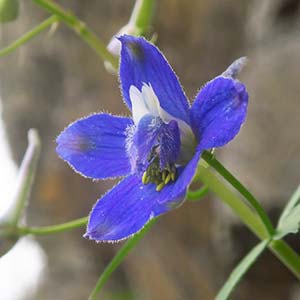Delphinium hansenii
Delphinium basalticum
Eldorado larkspur, Hansen's delphinium, Hansen's larkspur
basalt larkspur, basaltic larkspur, Columbia Gorge larkspur
(25-)40-80(-180) cm;
base usually reddish, pubescent.
20-50(-65) cm;
base often reddish, puberulent.
blade pentagonal, 1.5-5 × 2.5-8 cm, long-pubescent, especially abaxially; ultimate lobes 0-18, width 4-20 mm (basal), 2-9 mm (cauline).
blade round, 2-6 × 5-9 cm, not succulent, nearly glabrous; ultimate lobes 5-19, width 3-15 mm (basal), 1-12 mm (cauline).
(9-)15-40(-160)-flowered, dense to open;
pedicel 0.3-2.5(-6) cm, puberulent;
bracteoles 1-5(-8) mm from flowers, green, sometimes white-margined, linear-lanceolate, 2-6(-8) mm, puberulent.
(2-)6-16(-26)-flowered;
pedicel 2-7 cm, nearly glabrous;
bracteoles 4-12 mm from flowers, green, linear, 3-7 mm, nearly glabrous.
sepals violet to white, ± puberulent, lateral sepals spreading to forward pointing, 7-10(-13) × 3-6(-8) mm, spurs gently upcurved, ascending 0-30° above horizontal, (6-)9-13(-16) mm;
lower petal blades elevated, ± exposing stamens, 3-7 mm, cleft 1-2(-4) mm;
hairs centered, densest on inner lobes near base of cleft, white.
sepals dark blue, nearly glabrous, lateral sepals spreading, 15-21 × 7-10 mm, spur straight to decurved, ascending 30-45° above horizontal, 14-18 mm;
lower petal blades slightly elevated, ± exposing stamens, 7-9 mm, cleft 4-5 mm;
hairs centered, mostly on inner lobes above base of cleft, yellow to white.
8-20 mm, 2.2-4 times longer than wide, glabrous.
12-17 mm, 3.5-4 times longer than wide, glabrous.
echinate, appearing fuzzy to naked eye;
seed coat cells with margins straight, surfaces sparsely pustulate.
± wing-margined;
seed coat cells with surfaces smooth.
Delphinium hansenii
Delphinium basalticum
Subspecies 3 (3 in the flora).
Although Delphinium hansenii has often been confused with D. hesperium, seeds will instantly allow identification. Seeds of Delphinium hansenii are, as far as known, unique, bearing numerous, elongate, prismlike raised structures (extensions of single cells or small groups of cells) over the entire seed coat. If seeds are absent, larger flowers, more open inflorescences (except in D. hesperium subsp. cuyamacae), and general absence of pubescence of long hairs in D. hesperium are apparent upon comparison of the two species. Separating D. hansenii from D. variegatum may also be difficult. Again, seeds leave no doubt. In addition, smaller flowers and greater number of flowers per plant of D. hansenii should serve to distinguish D. hansenii from D. variegatum. White-flowered D. hansenii has been confused with D. gypsophilum and with D. hesperium subsp. pallescens. Other than seeds, pubescence of long hairs and smaller flowers present in D. hansenii and absent in the others will distinguish them.
(Discussion copyrighted by Flora of North America; reprinted with permission.)
Of conservation concern.
Hybrids between Delphinium basalticum and D. trolliifolium are known.
(Discussion copyrighted by Flora of North America; reprinted with permission.)
1. Sepals reddish purple to dark maroon. | subsp. ewanianum |
1. Sepals dark blue-purple to white. | → 2 |
2. Leaves primarily basal (although leaves may be dry at anthesis and thus lost in herbarium specimens, petiole base will be present); cauline leaves usually fewer than 3; sepals bright blue to white. | subsp. kernense |
2. Leaves primarily cauline, basal leaves usually absent at anthesis; cauline leaves 3 or more; sepals dark blue-purple to white or pink. | subsp. hansenii |


